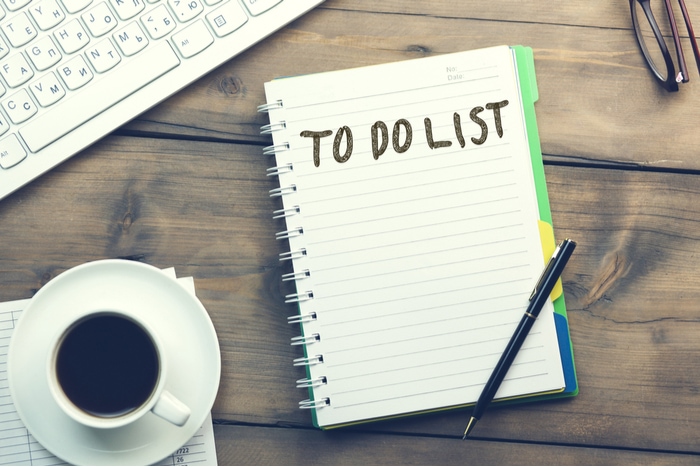Let’s be honest: all entrepreneurs struggle with productivity during working hours. But you also know that you’ll never make money as a freelancer if you spend your time scrolling Facebook or staring at a blank screen.
In addition to the issue of making an income, there’s the constant pressure to maintain some semblance of a work-life balance. The longer it takes you to get your work done, the less time you’ll have to enjoy a life outside of work.
With these considerations in mind, how can you keep yourself accountable when there’s no clock to punch and no boss looking over your shoulder?
Here are four tips to keep you on track when you work as a freelancer. By following these guidelines, you can start building the business — and the life — that you want.
1. Have a vision for what your freelance business will become
Beyond your day-to-day tasks and projects, there are likely some things you want to accomplish in the long term. And whatever your goals are, you need a plan as to how you’re going to achieve them.
Begin with an overall vision of what you want your business and lifestyle to look like in future years. Then, keep that vision in mind with every decision you make. Whenever you hit a fork in the road — for instance, choosing whether to take on a new project or cut back on existing projects — that vision will be the compass that guides your direction.
In addition, some consultants use a deliberate process to turn their longer-term vision into smaller steps to take each month, each week and even each day. Over time, those smaller steps add up to the freelance business and lifestyle that you want. They’re all part of realizing your greater vision and defining a path forward.
What path? Your path. That’s the point of working for yourself — you get to choose the work you do. By pursuing work that truly interests you and aligns with your longer-term goals, you’ll be far less likely to drag your feet while doing it.
2. Help yourself get in the productivity zone
You’ll finish work a lot faster (and enjoy your downtime a lot more) if you can carve out time to focus fully on your core business activities — the stuff that you do best.
The first obvious step: turn off your cell phone or put it in another room. Or, if you need to keep your phone with you, you can put all of your apps (even your text messaging) into “Do Not Disturb” mode. If family members must be able to reach you in case of an emergency, there are ways to make exceptions in your cell phone settings.
Next, turn off email notifications on all your devices. If your clients need you to respond in five minutes, you have the wrong clients. Let them go as soon as you can and find people who appreciate your ability to dig deep and focus.
Finally, create a mental or physical spot in your life that is dedicated to working. For some people, this means keeping one computer for work only. Others prefer working in a certain coffee shop or taking over a particular area in their home during work hours. Whatever you choose, make sure you create a workspace that you enjoy – and that allows you to get stuff done.
3. Know when to take breaks
Repeat after us: humans are not robots. We all need to eat, sleep, socialize and move our bodies regularly in order to get work done. Being on the job 18 hours a day is not a sustainable solution.
Remember, you’re not working for a company anymore. You are your own business. You set the efficiency expectations and the schedule. A Harvard Business Review study found that working long hours — a notorious corporate life trick to show how hard you’re working — is actually bad for productivity.
Some people take a rigid approach to scheduling and follow the Pomodoro Technique — they work for 25 minutes and then take a break for five. Others work for hours until they are tired, then take a long walk or do some chores before getting back down to business.
Of course, we can’t tell you when or how often to take breaks. It’s your body and it’s your business. Just make sure that you respect yourself and your health when deciding how much work to take on.
4. Use technology to enhance your productivity
To paraphrase the “Hunger Games”, may the odds be tilted in your favor. While a lot of people may use technology as a distraction from work, you can actually use it to save time.
First, think of all the mundane, routine tasks you must do as a freelancer — bookkeeping, phone call scheduling, and the like — and use a program like Zapier to automate these tasks. If your budget permits, you could also hire a virtual assistant to take care of these tasks for you.
Next, consider moving all of your clients and projects out of Excel spreadsheets and into a proper client management tool like Method CRM. By keeping all of your essential data in one location, you’ll spend less time hunting around for phone numbers, meeting notes, and invoices. You can also respond to client emails faster and see exactly what you need to do each day at a glance.
Finally, look for opportunities to integrate your existing apps whenever possible. Double data entry is a huge time-waster for any business — but when the business is just you, repetitive tasks literally bring productive work to a halt. Choosing a client management system that integrates with QuickBooks makes quoting, invoicing, and receiving payments as simple as possible, so you have more time to focus on your real work.
Conclusion
When you start your career as a freelancer, it can be overwhelming to develop a productivity system. Just as settling into a new job takes time, so does identifying the goals, routines, schedules, and tools that enable you to work effectively for yourself. But once you figure it out, you’ll be amazed by what you can accomplish in a day — both on and off the clock.






